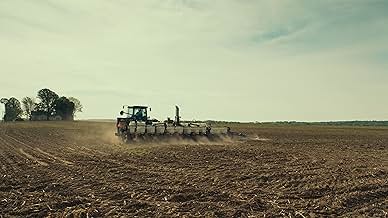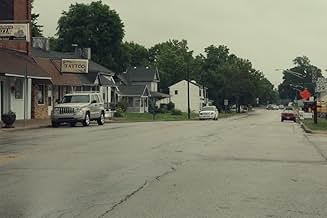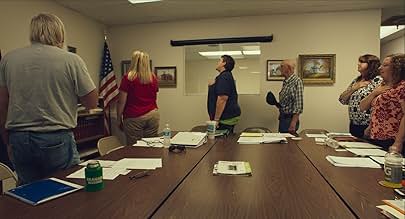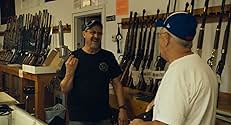Después de las elecciones presidenciales de 2016, en la pequeña ciudad de Monrovia se trata de comprender cómo sus valores impactan e influyen en el panorama político de la nación.Después de las elecciones presidenciales de 2016, en la pequeña ciudad de Monrovia se trata de comprender cómo sus valores impactan e influyen en el panorama político de la nación.Después de las elecciones presidenciales de 2016, en la pequeña ciudad de Monrovia se trata de comprender cómo sus valores impactan e influyen en el panorama político de la nación.
- Dirección
- Premios
- 1 premio ganado y 4 nominaciones en total
Opiniones destacadas
In my opinion, Frederick Wiseman is the greatest documentary film maker of all time and here he looks at life in Monrovia, Indiana a small town farming community.
As in other Wiseman films, there is no narration, interviews or leading questions. He simply allows us to get a glimpse into the lives of people living here. He starts off with some beautiful shots of blue skies, breezes blowing through the trees and fields. Then we see towns folk going about their business in their jobs and everyday life. Only Wiseman could make working in a pizzeria or a supermarket seem fascinating. The early scenes shows the Monrovia High School, showing a teacher proudly talking about Indiana basketball players, there is also a quick scene of students rehearsing a musical revue. There is no scenes of any trouble at the school, unlike Wiseman's 1968 classic "High School". One of the funnier moments is a group of older men at a diner talking about diet food and drinking a lot of beer to get it down. We see a pig farmer getting his pigs ready to be sold. Wiseman spares us from seeing them slaughtered which I thought was unusual for him since he normally shows us everything. However later on, we get to see a veterinarian operating on a dog's tail reminiscent of the operation we got to see in Wiseman's 1993 "Zoo". There are a few long sequences of the town council discussing new houses being built and lack of fire hydrant inspections. A wedding is shown in a Christian church with nice singing of the old song "Always". There is a scene in a gun shop where owner and customer talk about rifle scopes for deer hunting and about a friend with gall stones. The final sequence is the funeral of a beloved wife and mother. Wiseman is always great at giving a well rounded picture of his subjects. The last scene of the coffin being lowered is very moving. It is often the last scene of a Wiseman film that hits you the hardest, and that is what happens here.
While this is not one of Wiseman's best, it still is a worthy addition to his collection.
As in other Wiseman films, there is no narration, interviews or leading questions. He simply allows us to get a glimpse into the lives of people living here. He starts off with some beautiful shots of blue skies, breezes blowing through the trees and fields. Then we see towns folk going about their business in their jobs and everyday life. Only Wiseman could make working in a pizzeria or a supermarket seem fascinating. The early scenes shows the Monrovia High School, showing a teacher proudly talking about Indiana basketball players, there is also a quick scene of students rehearsing a musical revue. There is no scenes of any trouble at the school, unlike Wiseman's 1968 classic "High School". One of the funnier moments is a group of older men at a diner talking about diet food and drinking a lot of beer to get it down. We see a pig farmer getting his pigs ready to be sold. Wiseman spares us from seeing them slaughtered which I thought was unusual for him since he normally shows us everything. However later on, we get to see a veterinarian operating on a dog's tail reminiscent of the operation we got to see in Wiseman's 1993 "Zoo". There are a few long sequences of the town council discussing new houses being built and lack of fire hydrant inspections. A wedding is shown in a Christian church with nice singing of the old song "Always". There is a scene in a gun shop where owner and customer talk about rifle scopes for deer hunting and about a friend with gall stones. The final sequence is the funeral of a beloved wife and mother. Wiseman is always great at giving a well rounded picture of his subjects. The last scene of the coffin being lowered is very moving. It is often the last scene of a Wiseman film that hits you the hardest, and that is what happens here.
While this is not one of Wiseman's best, it still is a worthy addition to his collection.
Here's an inside look at the workings of a town in the U. S. heartland. We see the people of Monrovia at their feedlots, corn fields, municipal hearings, schools and places of worship - a great panorama of life in this good place. Some Midwestern stereotypes are knocked down here, not on purpose but as revealed by the responsible way these people act. As a viewer I thank the people of Monrovia - and it's an impressive cross-section of people - for granting access to so much of what matters in this community. There is a bit of self-deprecation, people of Monrovia acknowledging they live in a small town. But in fact it's a big place, in civic spirit and caring for others.
For the record, I arrived 5-10 minutes late.
This documentary provides a well seamed collection of examples of everyday life in a place I've never heard about. History of their sports teams, debates over investing in new residential housing vs new businesses (the newest neighborhood is where the majority of their volunteer firefighters and people who returned to Monrovia reside), freemasons ceremony, WTH is up with the newest neighborhood's fire hydrants, barbershop, hair salon, fitness class, a funeral, etc. Monrovia, Indiana does well at what it intends. This would be an interesting documentary to discuss academically.
Side Note: I did lose my interest at times, but that's a matter of personal taste. Some topics just didn't interest me. The director did a pretty decent job with editing. I give that a B.
This documentary provides a well seamed collection of examples of everyday life in a place I've never heard about. History of their sports teams, debates over investing in new residential housing vs new businesses (the newest neighborhood is where the majority of their volunteer firefighters and people who returned to Monrovia reside), freemasons ceremony, WTH is up with the newest neighborhood's fire hydrants, barbershop, hair salon, fitness class, a funeral, etc. Monrovia, Indiana does well at what it intends. This would be an interesting documentary to discuss academically.
Side Note: I did lose my interest at times, but that's a matter of personal taste. Some topics just didn't interest me. The director did a pretty decent job with editing. I give that a B.
Although Monrovia is a boring small town in mid west I'm sure some people there have interesting things to say or have deep inner lives but Wiseman didn't reach this and so this was the most boring film I've seen in ages.
The director captured the essence of Indiana small-town life perfectly in this PBS documentary. The citizens of Monrovia are exactly the same personality types that I met during my time in rural Indiana about 40 years ago. It appears that nothing has changed.
I lived in Clayton, Indiana for about 4 years. Clayton is very close to Monrovia, which had the only bank in the area. I came from the Seattle, WA area, so the whole culture and landscape of Clayton and Monrovia were foreign to me - the flat fields as far as the eye could see and beyond. The social life of people in these farm areas is very structured and life experiences are limited by the narrow perspective of a strictly proscribed culture. I ended up in Indiana because my husband and I wanted to established a thoroughbred stud farm and his parents had a large parcel of land. When we got there and realized what a different landscape and social structure we found ourselves, I regretted moving there almost immediately. I was in a strange place and I had a lot to learn about middle America culture. People knew that I was not local. Not just from my (non-Southern) accent, but from my questions about (1) the religious emphasis in daily life, l(2) seeming lack of interest in local or national government, and (3) attitudes about women and their "place" in society.
After returning to the Pacific Northwest after 4 years and Iooking back on my experiences in Clayton and Monrovia, I had a better idea about how people in different parts of America think about life and society in general. Where we live molds our perspective through exposure to different people and different landscapes.
I lived in Clayton, Indiana for about 4 years. Clayton is very close to Monrovia, which had the only bank in the area. I came from the Seattle, WA area, so the whole culture and landscape of Clayton and Monrovia were foreign to me - the flat fields as far as the eye could see and beyond. The social life of people in these farm areas is very structured and life experiences are limited by the narrow perspective of a strictly proscribed culture. I ended up in Indiana because my husband and I wanted to established a thoroughbred stud farm and his parents had a large parcel of land. When we got there and realized what a different landscape and social structure we found ourselves, I regretted moving there almost immediately. I was in a strange place and I had a lot to learn about middle America culture. People knew that I was not local. Not just from my (non-Southern) accent, but from my questions about (1) the religious emphasis in daily life, l(2) seeming lack of interest in local or national government, and (3) attitudes about women and their "place" in society.
After returning to the Pacific Northwest after 4 years and Iooking back on my experiences in Clayton and Monrovia, I had a better idea about how people in different parts of America think about life and society in general. Where we live molds our perspective through exposure to different people and different landscapes.
¿Sabías que…?
- TriviaShot in ten weeks.
Selecciones populares
Inicia sesión para calificar y agrega a la lista de videos para obtener recomendaciones personalizadas
Detalles
Taquilla
- Total en EE. UU. y Canadá
- USD 63,944
- Fin de semana de estreno en EE. UU. y Canadá
- USD 5,172
- 28 oct 2018
- Total a nivel mundial
- USD 64,596
- Tiempo de ejecución
- 2h 23min(143 min)
- Color
- Relación de aspecto
- 1.85 : 1
Contribuir a esta página
Sugiere una edición o agrega el contenido que falta






















